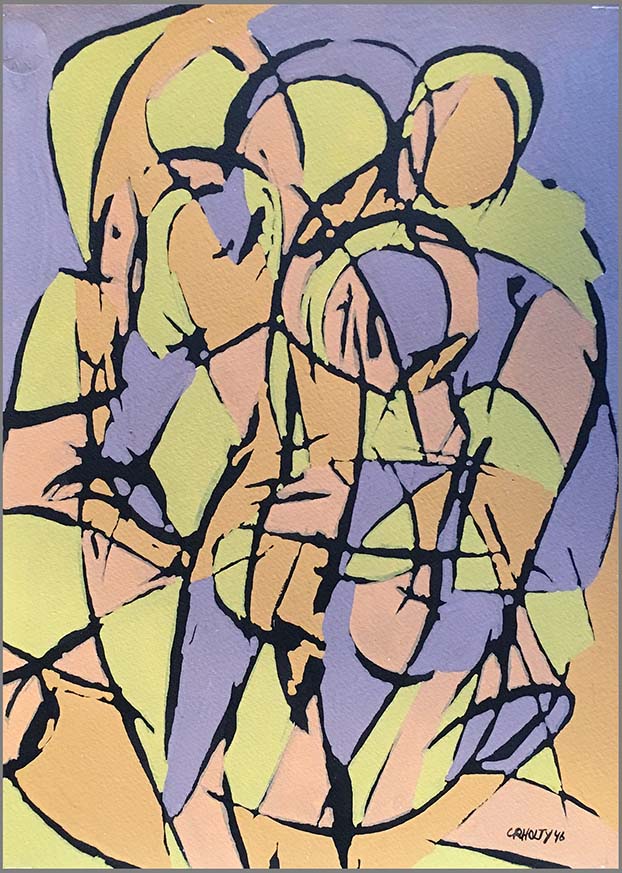Abstractionist Carl Robert Holty was known for his biomorphic abstract forms as well as the geometric abstractions he painted with his vibrant color palette. Born in Frieburg, Germany in 1900, Holty's family emigrated to the United States within a year of his birth. There they settled in Milwaukee, Wisconsin. From a young age Holty's raw artistic talent fueled his determination to distinguish himself in the art world. In 1919, he enrolled at the Art Institute of Chicago, and shortly thereafter attended the Parsons School of Design. He spent a short time at the National Academy of Design and studied with Francis Coates Jones, younger brother of H. Bolton Jones, the well-known landscape artist. In 1923 Holty returned to his hometown of Milwaukee, where he aspired to make his career as a portraitist.
After he married Holty and his new bride crossed the Atlantic so he could study at the prestigious Royal Academy in Munich, Germany. While en route, a chance meeting with friend and fellow artist, Vaclav Vytlacil, led to Holty switching his enrollment to the Hans Hofmann's school instead. At the Hofmann School Holty was exposed to the world of Abstract Expressionism—a style that would come to define much of his future work. In 1927 Holty’s wife contracted tuberculosis so he withdraw from Hofmann's school in order to relocate his wife to Switzerland for treatment. Despite his short tenure at the Hofmann school, Holty maintained a personal friendship with Hofmann, and continued to incorporate Hofmann's teachings into his work.
Holty’s early work shows influences of Fauvist colors and the work of French artists Maurice de Vlaminck and André Derain. Following his studies at the Hofmann School of Art in Munich, Holty traveled extensively throughout Europe and Northern Africa. Although he is strongly linked to the Abstract Expressionist and Geometric Abstractionist Movements, it is important to note that Holty also experimented with Abstract Creationism, which swept through Paris in 1932. The artist Robert Delaunay sponsored Holty's membership to Paris's Abstraction-Creation Group, where Holty found greater artistic acceptance than at home in the US. The Group published some of Holty's curvilinear abstractions in their magazine the following year. His true passion lay in exploring the Cubism and Neo-plasticism of Mondrian, and after a year's membership, Holty left the Group to explore these techniques.
Upon his return to the United States, Holty played a major role in the establishment and successful operation of the American Abstract Artists organization in New York, an organization comprised mainly of European modernists. He became the chairman in 1938 and exhibited his work with them until his departure from the group in 1944. He also surrounded himself with his old friends from Europe, including Hans Hofmann, Vaclav Vytlacil, and Stuart Davis. His strong advocacy for modern art brought the American art scene exposure to emerging styles, and helped to establish him as a leading American Abstract painter.
Holty's work in the 1930s shows an aesthetic awareness and technical execution derivative of the stylings of Juan Gris, the Synthetic Cubism developed by Pablo Picasso, and even the Organic Surrealism of Joan Miro. Soon he developed his own personal interpretations and application of Cubist concepts which ultimately became biomorphic shapes whose sense of movement became less and less constrained by the Cubist spatial principles. Holty did not give way completely to his inclinations to stretch the structure and guiding principles of Cubism. He respected the structure as well, and its influence is present in his work. He was known to have used tape in order to ensure crisp and exact lines for each form on the canvas. The 1940s saw Holty continue to push the boundaries of Cubist structure with the freedoms of abstract expressionism, while adhering to its technical and aesthetic guidance. By the 1950s, Holty's name had become forever linked to American abstractionism with its large, soft-edged color forms mixing with or floating on chromatic stains. By the 1960s, Holty found himself immersed in experimentation with the relationship between space and form within two-dimensional planes. Using his technical abilities to combine thinly layered tones with a subtly of color, Holty's renderings of space challenged the American art community to see the world in new and cutting-edge ways.
Holty passed away on March 22, 1973 after a long and prolific artistic career. He was survived by his second wife, Elizabeth and daughter from that marriage, Antonia. His teaching career included two years at the Arts Students League in New York and six years at Brooklyn College. In 1970 Holty was given the title of Professor Emeritus of Brooklyn College. A major contributor to the Modernism and Abstract Expressionism in the States, Holty's work continues to influence the world of American painting.
Written and compiled by Hali Thurber |
|

